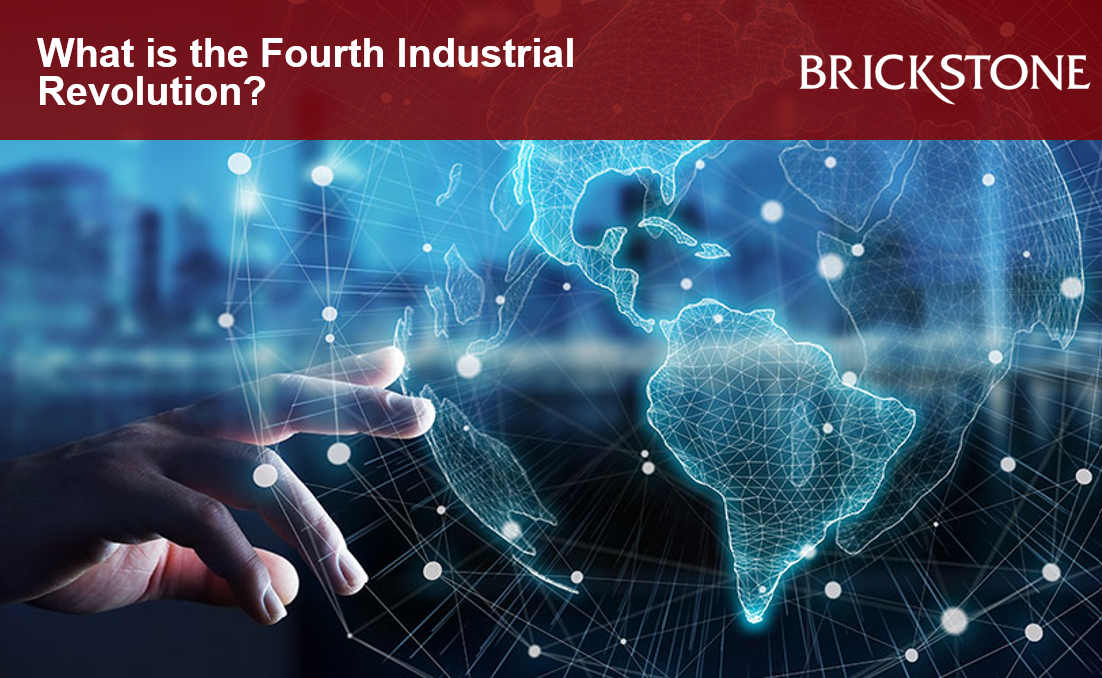What is the Fourth Industrial Revolution?
The First Industrial Revolution used water and steam power to mechanize production. The Second used electric power to create mass production. The Third used electronics and information technology to automate production. Now, a Fourth Industrial Revolution is building on the Third, the digital revolution that has been occurring since the middle of the last century. It is characterized by a fusion of technologies that is blurring the lines between the physical, digital, and biological spheres.
This article by Brickstone reviews some institutional reports and publications on the Fourth Industrial Revolution, highlighting key facts and insights.
The Fourth Industrial Revolution
According to McKinsey, Fourth Industrial Revolution, also called Industry 4.0 or 4IR, is the next phase in the digitization of the manufacturing sector, driven by disruptive trends, including the rise of data and connectivity, analytics, human-machine interaction, and improvements in robotics.
Like the three that preceded it, the Fourth Industrial Revolution will mark a significant change in the way we we live, interact and do business. The Fourth Industrial Revolution builds on the inventions of the Third Industrial Revolution—or digital revolution—which unfolded from the 1950s and to the early 2000s and brought us computers, other kinds of electronics, the Internet, and much more. Industry 4.0 brings these inventions beyond the previous realm.
Augmented reality, machine automation, and more: the 21st-century industrial revolution is digital. Increased productivity, efficiency and quality in processes, greater safety for workers by reducing jobs in dangerous environments, and enhanced decision making with data-based tools are core to its advantages.
The following are key facts and insights about the fourth industrial revolution:
According to the IAP, Fourth Industrial Revolution (4IR) is a term coined in 2016 by Klaus Schwab, Founder and Executive Chairman of the World Economic Forum (WEF). It is characterized by the convergence and complementarity of emerging technology domains, including nanotechnology, biotechnology, new materials and advanced digital production (ADP) technologies.
Industry 4.0, the Fourth Industrial Revolution, and 4IR all refer to the current era of connectivity, advanced analytics, automation, and advanced-manufacturing technology that has been transforming global business for years. This wave of change in the manufacturing sector began in the mid-2010s and holds significant potential for operations and the future of production.
The Fourth Industrial Revolution encompasses the Internet of Things, but goes beyond simple device connectivity toward being an Internet of Everything. At its core is the combination of big data, analytics and physical technology. The aim is to provide increasingly enhanced, customized offerings to help meet the needs of individuals and organizations that can adapt and evolve to changing situations and requirements over time.
The fourth industrial revolution is built around four fundamental types of disruptive technologies that can be applied all along the value change. They include, connectivity, data, and computation power; analytics and intelligible; human-machine interaction and advanced engineering.
Technology, however, is only half of the Industry 4.0 equation. To thrive in the Fourth Industrial Revolution, companies must ensure that their workers are properly equipped through upskilling and reskilling and then hire new people when necessary. This is increasingly vital as disruptive technologies transform job requirements. The end-to-end skill transformation has three phases – scout, shape and shape.
On the advantages of the fourth industrial revolution, this transitioning phase could make products and services more easily accessible and transmissible for businesses, consumers, and stakeholders all along the value chain. Preliminary data indicate that successfully scaling 4IR technology makes supply chains more efficient and working hours more productive, reduces factory waste, and has countless other benefits for employees, stakeholders, and consumers.
The Fourth Industrial Revolution creates opportunities for sustainability and, more important, these advances are inherently more sustainable than current business practices. Some people think productive operations are hard to square with environmental responsibility, but sustainable lighthouses challenge that notion: 4IR transformations facilitate a viable kind of eco-efficiency that intrinsically meshes sustainability with competitive excellence.
With artificial intelligence still in its infancy and data analytics still highly dependent on human oversight, we are still some way away from truly autonomous, self-optimizing systems. What’s more, this is a continually-evolving area, with no agreed standards when it comes to data formats or coding protocols. Getting different systems to effectively communicate to drive efficiencies is an issue. However, these challenges are not just technological, as the free flow of data lies at the heart of this revolution, thereby leading to concerns around privacy, which will require regulatory recommendations. Fears about artificial intelligence are also likely to lead to new laws requiring human oversight to counter ethical concerns about automated decision-making.
Industry 4.0 will continue to have a significant impact on the economy. The greatest economic boons will go to the fastest-acting companies. According to a 2018 McKinsey Global Institute analysis, Industry 4.0 front-runners—facilities well on their way to adopting AI and other advanced technologies by 2025—can expect a 122 percent positive cash flow change. Follower companies can expect just 10 percent, while companies that wholly fail to adopt AI could see a 23 percent downturn.
Industry 4.0 is also projected to transform the skill sets of the workforce by shifting the standards for sought-after talent. Over the coming decade, we will see these changes as more and more companies embrace robotics. According to McKinsey, in 2025, the value creation potential of Industry 4.0 for manufacturers and suppliers is expected to reach $3.7 trillion.
Learn more about the Fourth Industrial Revolution here.





